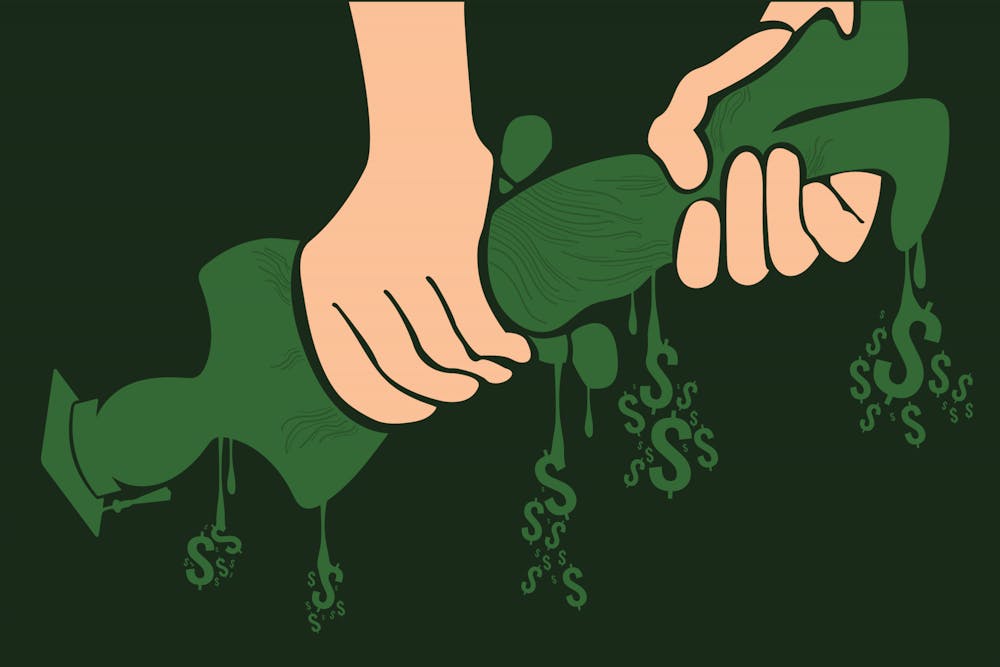The cost of college in the U.S. continues to rise to ridiculous heights. This is an unacceptable fact that must change.
At the University of South Carolina, the cost of in-state tuition alone (no meals, housing, books or supplies) is $12,688 for the 2021-2022 school year. Out-of-state tuition is even more inflated at $33,928.
Compare this to USC's tuition in 1977, which, when adjusted for inflation, comes out to $2,606. There has been a 387% increase of in-state tuition over the last 44 years.
It would be one thing if this was an unique problem to South Carolina — but the truth of the matter is that these numbers represent a nationwide trend.
The U.S. Department of Education's National Center for Education Statistics tracked the average costs of college, starting from the 1985-1986 school year and ending with the 2018-2019 school year.
For both four-year and two-year public and private institutions, the cost, adjusted for inflation, in 1985-1986 was an average of $11,369. By 2018-2019, that number more than doubled to $24,623.
To make matters worse, this rise in costs has not been offset by the average increase in wages for the U.S.
This means students and their families need to find other ways to pay their tuition.
For example, third-year marketing student Connor Bolton said that his parents have had to take "ridiculous" steps to try and pay for his education, such as getting help from a financial service.
Typically, though, the method used to compensate for costs are student loans.
In 2019, a study estimated that 70% of students graduate with debt, averaging around $30,000. Meanwhile, the population of the U.S. as a whole owes a whopping $1.6 trillion (and climbing) in student loans.
While many are able to successfully pay back these loans and have a successful life afterward, a study reported 30% of people are unable to pay back their loans within six years. To make matters worse, it is reported that an estimated 65% of jobs require some kind of college degree.
As tuition costs continue to rise and people take on massive amounts of debt to stand a chance in the job market, this problem seems likely to compound.
Eric Powers, associate professor of finance at the Darla Moore School of Business, explained these drastic price increases.
“There was an arms race in amenities that occurred. So, for example, we built the Strom Thurmond fitness center. We built a lot of new dorms that are really nice, way nicer than anything I stayed in when I was in college in 1982 through 1986,” Powers, chair of the school’s Department of Finance, said.
This rush of building amenities wasn’t simple overspending, but rather a strategic choice made by colleges. However, the true reason for heightened tuition is not that simple. Another change has been a "consistent drop" in state funding, or appropriations, to state universities, Powers said.
“South Carolina has been probably as bad as any state in that drop in appropriations," Powers said. "We actually make more from things like concession sales than we get in terms of state revenue."
These causes can be remedied, though. State funding to state universities should be increased across the board, as education should be valued and made as accessible as possible.
Any action should be taken to ensure colleges and universities don’t become completely unaffordable and therefore inaccessible to people in the future. Before universities decide to add new amenities to its campus, it should make sure the financial burden does not fall on the students.
"I think some of the ways that schools spend some of their money is, if I'm being totally honest, it can look a little ridiculous," second-year psychology student Rhianna Thomas said. "Choosing what they choose to spend money on sometimes, maybe as a student, doesn't make a lot of sense to all of us, especially if not all of us are getting those amenities."
While the existence of amenities is beneficial to students, the amount of costs they have levied on students is unfair, and they are not what the university should be spending state funding and tuition on. The quality of the education should come first, no matter what.

